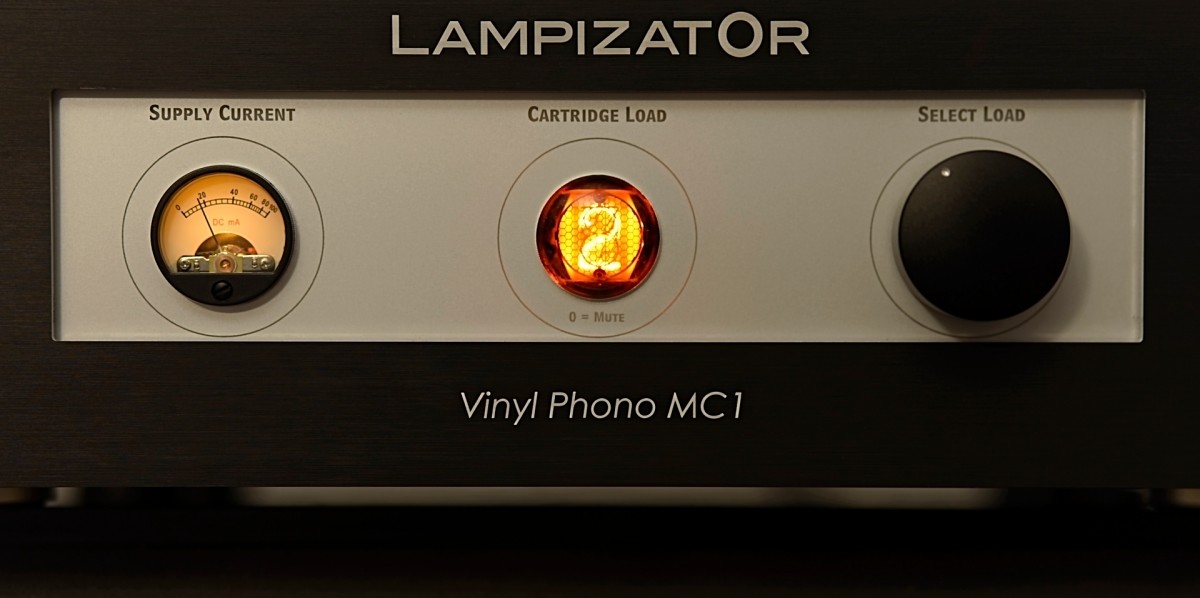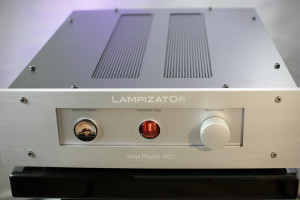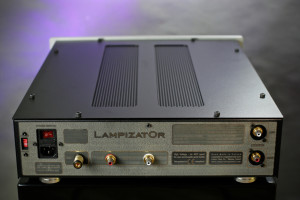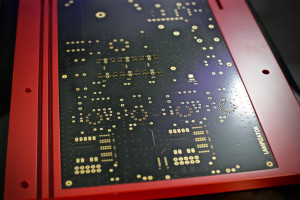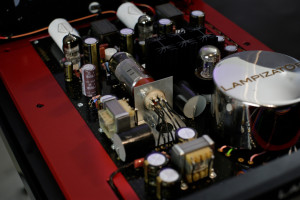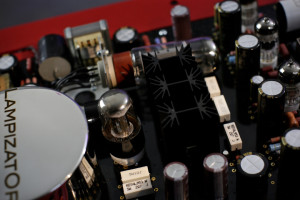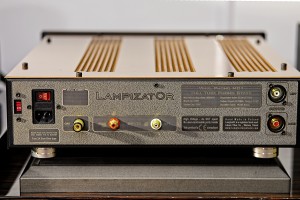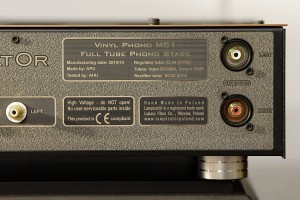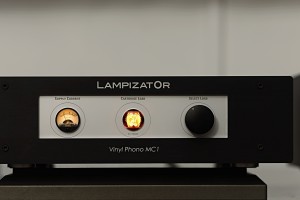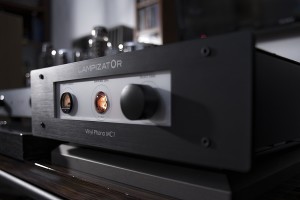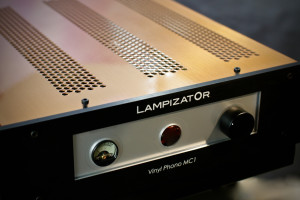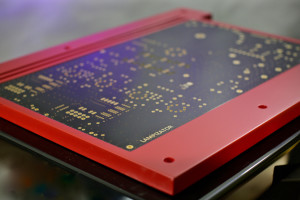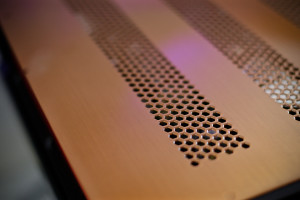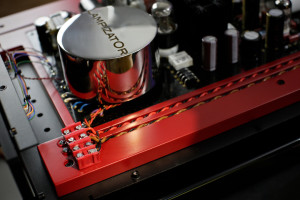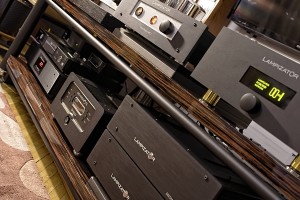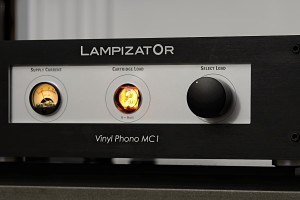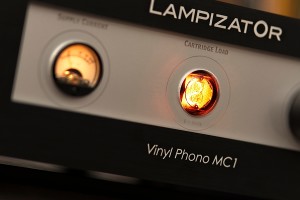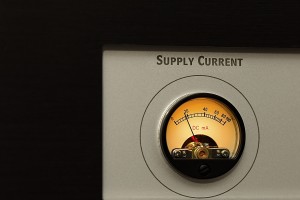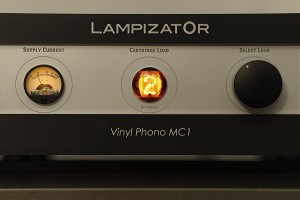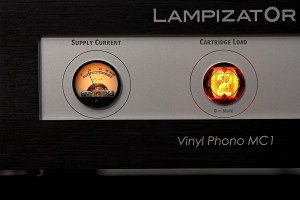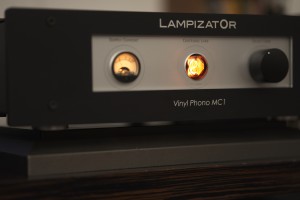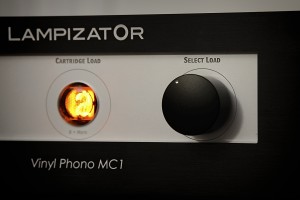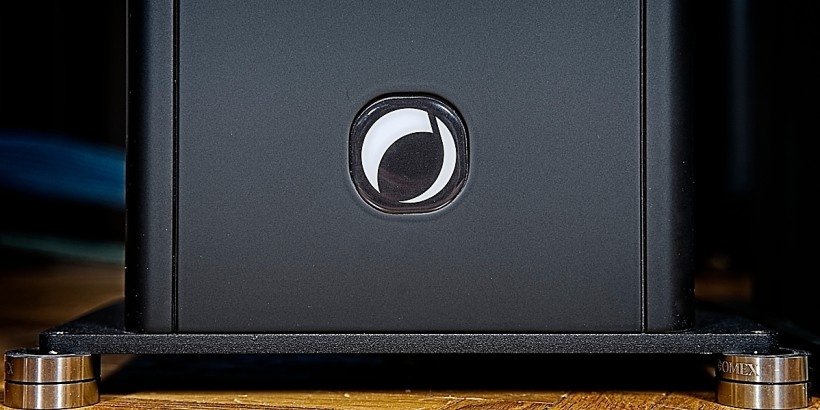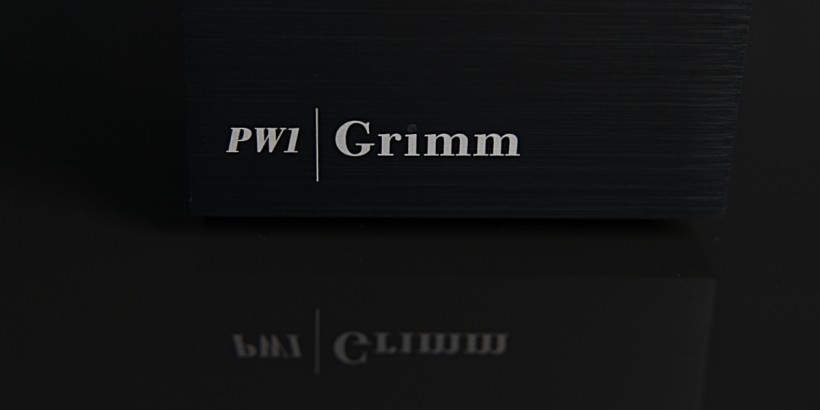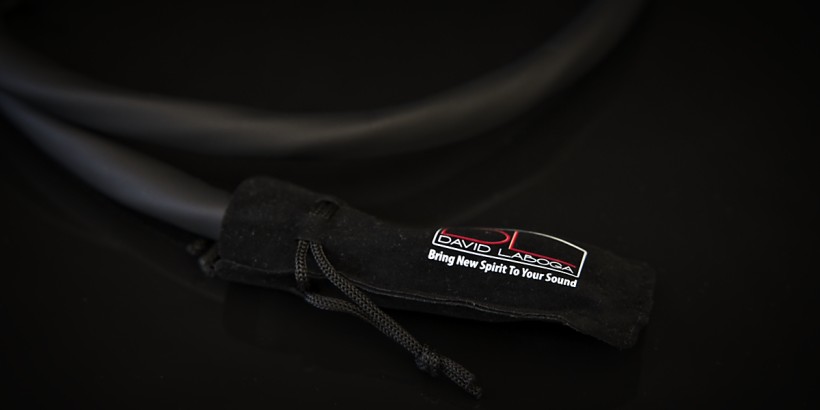Fully tubed. Designed to amplify signal from a Moving Coil cartridges. It looks somewhat familiar. What is it? The first ever phonostage prepared by Łukasz Fikus and his crew, the LampizatOr Vinyl Phono MC1!
Introduction
For several years now, the LampizatOr has been associated primarily with excellent digital-to-analog converters. It’s not just one of many brands offering this type of device, but actually one of the leaders in terms of sound quality. The latter is not the only distinguishing feature though. Unlike most competitors LampizatOr offers its customers an opportunity to shape the sound of their high-end D/A Converters. That’s what top models, Big7, Golden Gate and Pacific have to offer – by using various types of tubes in the output stage user is able to tune (to a quite significant extent) the sound coming from the speakers. DACs are by no means the only type of audio components offered by the Polish manufacturer, but undoubtedly Łukasz Fikus’ reputation is based primarily on them. The lineup includes also a custom computer, which can be used as a high-class source for DACs, also amplifiers, cables, power filter, and a separate brand manufacturers loudspeakers. So actually one can build a complete system with a digital source, tube or hybrid amplifiers, loudspeakers and a set of cables, all developed and manufactured by Lukasz Fikus companies. At least, unless someone is a fan of vinyl records. Until very recently, such a person had no choice but to purchase a phonostage from a different manufacturer.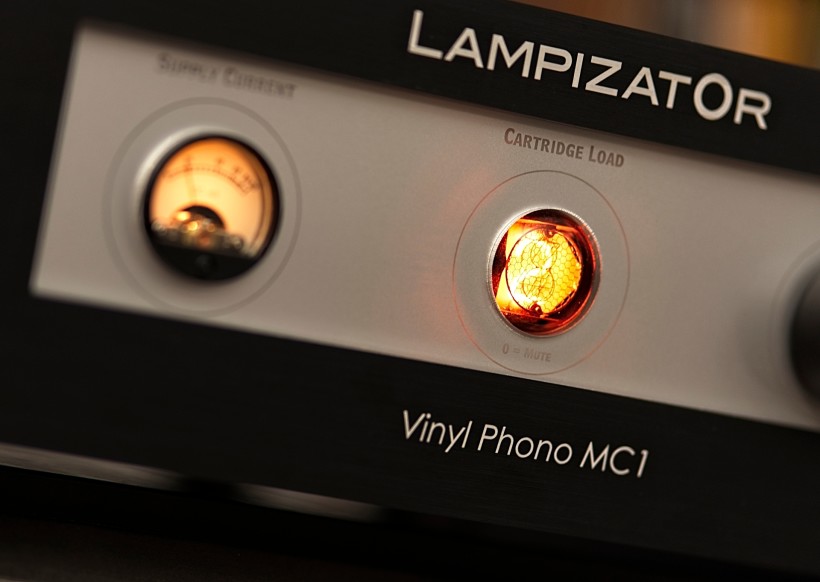 This is why the news that LampizatOr was working on their first phonostage that broke on social media in recent months was a huge surprise. It seemed that our digital-to-analog guru having achieved so much in this field decided to turn his eyes, or rather ears towards vinyl records. He decided, or maybe had been (finally!) convinced that there is more then one (I mean apart from the hi-res files) music medium that offers remarkable sound quality. The simplest way to get into the world of analog records would have been to buy some awesome set (actually, he bought a turntable, or even two) and enjoy listening to records at home. But no, that would have been to simple for him. He did not undertake designing and manufacturing his own turntable (at least for now, because who knows what the future will bring), but the phono preamplifier, yes, he did. Obviously, by design, it had to be a tube device – it is Lukasz Fikus’ forte after all. Since the goal was to develop a device for high-end systems, it had to support Moving Coil cartridges. From what Mr. Fikus told me, at first he simply prepared some prototypes based on available schemes. Since the sonic results were not satisfactory, he decided to develop something else from the scratch using his extensive knowledge of analog tube stages and power supplies.
This is why the news that LampizatOr was working on their first phonostage that broke on social media in recent months was a huge surprise. It seemed that our digital-to-analog guru having achieved so much in this field decided to turn his eyes, or rather ears towards vinyl records. He decided, or maybe had been (finally!) convinced that there is more then one (I mean apart from the hi-res files) music medium that offers remarkable sound quality. The simplest way to get into the world of analog records would have been to buy some awesome set (actually, he bought a turntable, or even two) and enjoy listening to records at home. But no, that would have been to simple for him. He did not undertake designing and manufacturing his own turntable (at least for now, because who knows what the future will bring), but the phono preamplifier, yes, he did. Obviously, by design, it had to be a tube device – it is Lukasz Fikus’ forte after all. Since the goal was to develop a device for high-end systems, it had to support Moving Coil cartridges. From what Mr. Fikus told me, at first he simply prepared some prototypes based on available schemes. Since the sonic results were not satisfactory, he decided to develop something else from the scratch using his extensive knowledge of analog tube stages and power supplies.
The result of many months of intense work is the Vinyl Phono MC1, in many ways an original device. When I read on the LampizatOr’s social media profile that the design was almost ready, I immediately declared that I would love to listen to the new product and test it as soon as possible. In my reference system I use two excellent solid-state phono preamplifiers. One of them is the ESE Lab Nibiru, that I reviewed a few months ago HERE. I have actually owned it for several years, but only after reviewing the latest version I decided to upgrade my unit. This is a relatively inexpensive (around EUR 2,300) device, but offering an excellent performance comparable to one from phonostages from a much higher price level. The second one in my system is the GrandiNote Celio mk IV , i.e. a device from a similar price level as the LampizatOr. It is also an extremely musical phonostage that turned out to be a perfect partner even for top-high-end cartridges and, despite solid-state design, it does offer a very “tube” sound in the best possible meaning of this word. I’ve always dreamed of a tube phonostage, but the ones that convinced me with their sonic qualities cost a lot, and I mean a LOT of money, so for now I am happy with these two exceptional solid-state performers.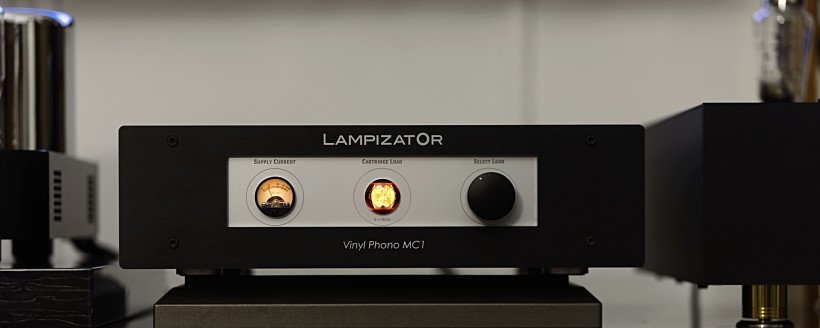 So when Vinyl Phono MC1 finally landed in my room it had a difficult task of competing with my two favorite toys, which rival mainly with each other for my attention (and I use them in turns), embarrassing many competitors I tested (usually the exceptions are only those that cost much, much more). The advantage of the Polish device is a tube-design through and through. From my experience most best phonostages there are, or at least those I reviewed (Tenor Audio, AudioTekne, Kondo, Ypsilon, Allnic Audio, AirTight) featured tubes in their design (only Tenor is a hybrid one). So I had high expectations for Vinyl Phono MC1. We agreed with Mr. Łukasz that he would bring the device to me for a few days first and let me decide whether it was worth a review. As you have probably guessed by now, I was impressed and so you can read this text now.
So when Vinyl Phono MC1 finally landed in my room it had a difficult task of competing with my two favorite toys, which rival mainly with each other for my attention (and I use them in turns), embarrassing many competitors I tested (usually the exceptions are only those that cost much, much more). The advantage of the Polish device is a tube-design through and through. From my experience most best phonostages there are, or at least those I reviewed (Tenor Audio, AudioTekne, Kondo, Ypsilon, Allnic Audio, AirTight) featured tubes in their design (only Tenor is a hybrid one). So I had high expectations for Vinyl Phono MC1. We agreed with Mr. Łukasz that he would bring the device to me for a few days first and let me decide whether it was worth a review. As you have probably guessed by now, I was impressed and so you can read this text now.
Design
I have to confess – when Mr. Łukasz brought his phono to my place I was surprised. I mean, I’d seen it on some photos before, but without any proper scale I couldn’t fully realize the size of this device. Its chassis dimensions are similar to those of the BIG7 DAC, which I once owned. It also weighs an impressive 17kg! With a few exceptions, such as the Tenor Audio Phono 1, Vinyl Phono MC1 is one of the largest phono preamplifiers I’ve had the pleasure to listen to in my room. One should take it into account, because despite the fact that it is equipped with six feet (which means if needed it can rest only on four of them), the phono’s depth (and one has to remember that cables must be still inserted into sockets on the rear which adds several centimeters) may make it difficult or even impossible to place it on a “standard” shelf / platform / rack. That’s what happened to me, as the LampizatOr did not fit onto the shelf of my Rogoz Audio rack, under the J. Sikora turntable. So I placed it next to the rack on the top anti-vibration platform also by Mr. Janusz Rogoz, the Finale/BBS. As it turned out, this forced marriage resulted in excellent sound. So please remember, if you buy or get the Vinyl Phono MC1 for a test, make sure you provide it with the best possible isolation from all vibrations – it will pay off.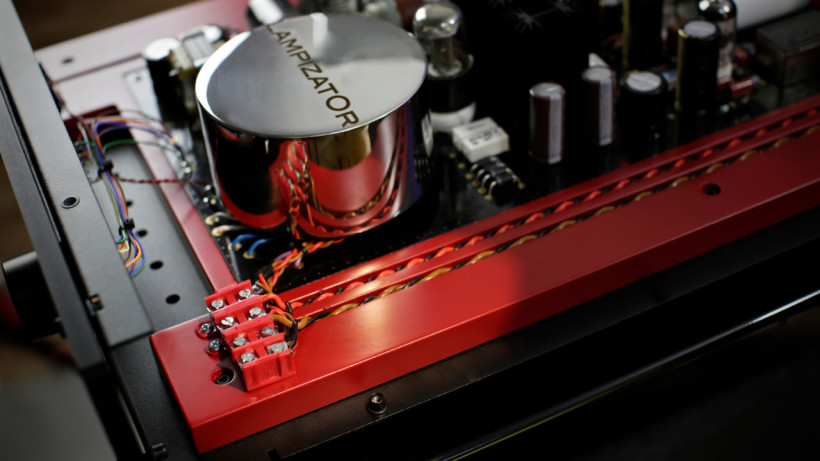 The Vinyl Phono MC1 has a classic LampizatOr look, so to speak. The thick aluminum front is available in black or silver. A large part of it was cut out, and underneath there is another silver plate with a small VA meter, which really only serves as an indicator of the tubes condition. Next to it there is a Nixie tube, which displays numbers indicating which of the five (0 = Mute, and the next digits are indicators of the 50, 100, 200 and 400Ω impedance, respectively, plus the number “5” is reserved for custom value) input impedance settings are selected with the knob sitting next to it. This is the only adjustable setting although if the four standard impedance values do not meet the needs of the buyer, it is possible to order a version with a specific impedance for specific cartridge. The standard version, which I listened to for the first few days, featured a black top cover, while the reviewed unit already had an optional copper one known from LampizatOr’s DACs (this is a paid option, and other colors are available upon request). The rear panel features high-quality RCA input and output sockets, grounding terminal, power supply socket and the main switch.
The Vinyl Phono MC1 has a classic LampizatOr look, so to speak. The thick aluminum front is available in black or silver. A large part of it was cut out, and underneath there is another silver plate with a small VA meter, which really only serves as an indicator of the tubes condition. Next to it there is a Nixie tube, which displays numbers indicating which of the five (0 = Mute, and the next digits are indicators of the 50, 100, 200 and 400Ω impedance, respectively, plus the number “5” is reserved for custom value) input impedance settings are selected with the knob sitting next to it. This is the only adjustable setting although if the four standard impedance values do not meet the needs of the buyer, it is possible to order a version with a specific impedance for specific cartridge. The standard version, which I listened to for the first few days, featured a black top cover, while the reviewed unit already had an optional copper one known from LampizatOr’s DACs (this is a paid option, and other colors are available upon request). The rear panel features high-quality RCA input and output sockets, grounding terminal, power supply socket and the main switch.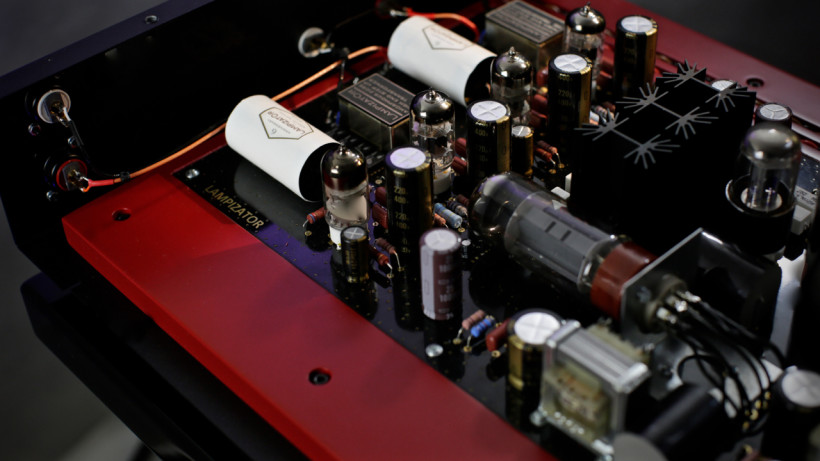 By design, the first phono in the history of the LampizatOr brand was to be a fully tubed device. As it is always the case with this type of design, the power supply is one of the absolutely critical elements. Therefore, it was decided to use a tube regulated power supply with a tube rectifier. For the latter, LampizatOr engineers chose the 6X5 tube. The Vinyl Phono MC 1 largely owes its impressive weight to a powerful transformer, as Mr. Łukasz told me, the best one currently made in our country. The preamplifier stage features two 6N2P-B and ECC803-s-g tubes as well as one EL34 in a NFB circuit. All passive elements were selected among the best available on the market with the best possible sound in mind. The Polish phono offers a permanent, as Mr. Łukasz described, maximum gain that could be achieved with this circuit. It’s clear that this is a puristic design – it allows user to connect only one tonearm/cartridge at the time, it has to be a MC one, impedance can be adjusted but gain is constant. This is how you build a device with ultimate performance in mind knowing it won’t be particularly versatile, but with high-end audio components the focus has to be on quality over versatility. It’s time to find out how the Vinyl Phono MC1 sounds like.
By design, the first phono in the history of the LampizatOr brand was to be a fully tubed device. As it is always the case with this type of design, the power supply is one of the absolutely critical elements. Therefore, it was decided to use a tube regulated power supply with a tube rectifier. For the latter, LampizatOr engineers chose the 6X5 tube. The Vinyl Phono MC 1 largely owes its impressive weight to a powerful transformer, as Mr. Łukasz told me, the best one currently made in our country. The preamplifier stage features two 6N2P-B and ECC803-s-g tubes as well as one EL34 in a NFB circuit. All passive elements were selected among the best available on the market with the best possible sound in mind. The Polish phono offers a permanent, as Mr. Łukasz described, maximum gain that could be achieved with this circuit. It’s clear that this is a puristic design – it allows user to connect only one tonearm/cartridge at the time, it has to be a MC one, impedance can be adjusted but gain is constant. This is how you build a device with ultimate performance in mind knowing it won’t be particularly versatile, but with high-end audio components the focus has to be on quality over versatility. It’s time to find out how the Vinyl Phono MC1 sounds like.
Sound
The first few days with the reviewed, already improved over the prototype (that had been already so good I wanted to review it) unit, I spent simply listening to the music and enjoying it. I selected some well known albums as well as some that collected dust (just on the covers, obviously) focusing exclusively on the music. The very fact that it was possible for me to forget about assessment strongly supported my initial impression that it was one hell of a phonostage. I love both phonostages that I own, even though they sound quite different from each other. And since these two are so good other models that come for reviews face a very difficult challenge of competing with them. Sometimes it happens that compared to my units, a reviewed item doesn’t really fare too well. It’s not about it sounding bad, but rather about not satisfying my high expectations. When it happens I can’t fully enjoy the records I know well, and it prevents me from getting completely immersed in music which is sort of a must from my perspective. It is all about music after all, isn’t it?
As already mentioned, nothing bothered me at all with LampizatOr though. I just kept picking up album after album and truly enjoyed myself. The Vinyl Phono MC1 worked great with my AirTight PC3 cartridge, although I had to push the potentiometer in the preamplifier bit further up the scale than usual. In a word, LampizatOr’s gain was slightly lower than in the case of Nibiru and Celio. For those who do not know these two devices let me just explain that they, same as the reviewed model, also do not feature an adjustable gain. Celio allows user to choose between “high” (for MC) and “low” (for MM) gain, and the former features no settings or adjustments of any sort. So comparing these three seemed to be a good idea, although at this stage I didn’t do any head-to-head comparisons yet.
Based on how I remembered the performance of my phonos, I quickly determined that LampizatOr’s was rather more similar to the Celio’s. Which was not a big surprise since Max Magri, the head of the GrandiNote, sometimes calls his devices ‘tube designs, but without tubes’ and these are not just empty words. His solid-state products do present many best features of tube devices and that’s why I value them so highly. Since the Vinyl Phono MC1 sounded similar (to a point) I liked it from the start too. LampizatOr, an actually tube design, offered a slightly warmer, richer, more weighty sound than the ESE Lab Nibiru. Which, in principle, was to be expected considering the tube design, but there were also some surprises. Not every album allowed me to assess it, but when it came to listening to the right ones, I heard clearly that the Vinyl MC1 was able to present not only a low, powerful bass, but that it was also tight, taut, fast, in a word, what one would expect from a solid-state design rather than a tube one. Still, in terms of richness and weight of the bass and midrange it sounded more like Celio. The Nibiru is even more impressive in terms of how fast, even immediate the attack is, how tight and well-differentiated the bass, but it is simply not as rich, as fleshy as with the LampizatOr or GrandiNote. The latter two do not suffer from any deficiencies in terms of timing or differentiation, they are not just that (I emphasize ‘that’, because they are very, very good in this respect, but still some competitors are even better) immediate and precise (contouring) when it comes to fast attack.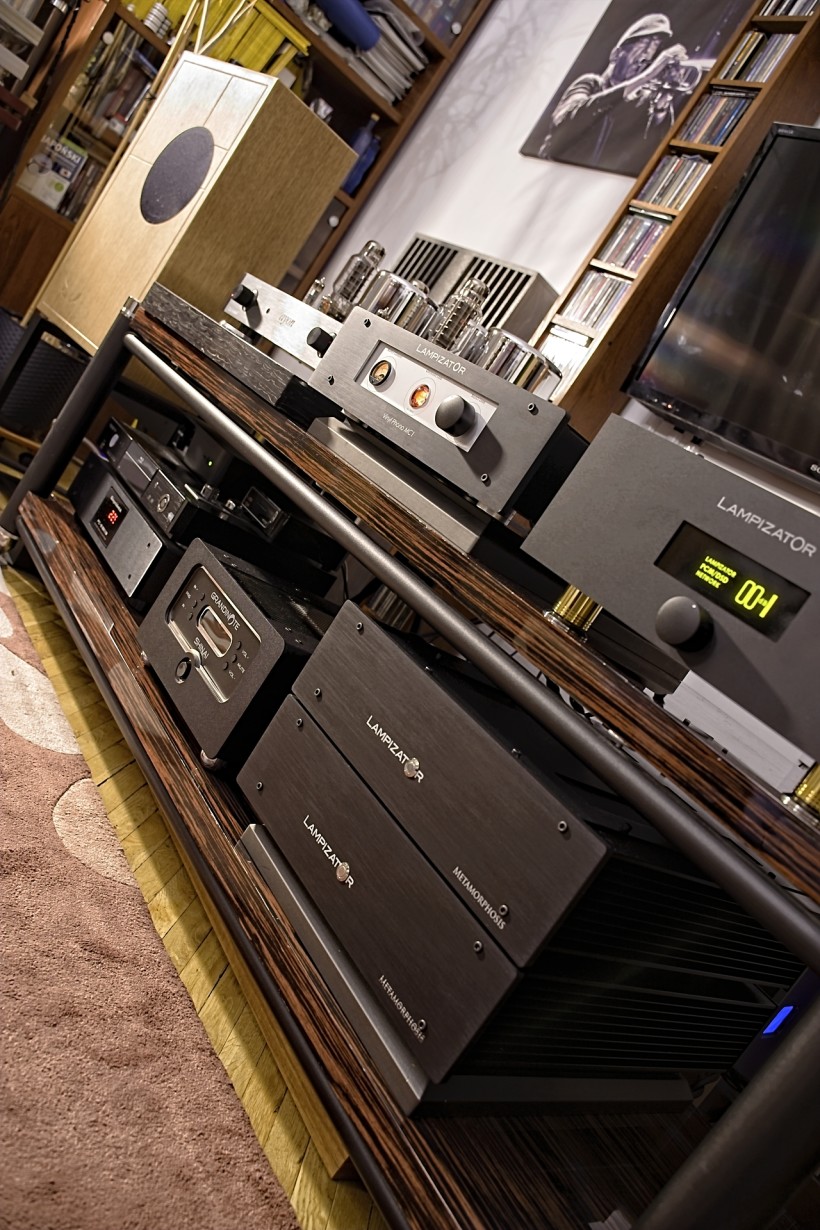 The immediacy of the attack is not the only advantage of the Polish phonostage. All I had to do was to play a few acoustic albums with a double bass or a piano to hear perfectly that also other phases of sounds, sustain and decay were presented in a very accurate way. Especially shortening of the reverberations and decay can be very annoying, but with LampizatOr it fortunately isn’t the case. Although Nibiru in terms of decay, e.g. on the beautiful Etta Cameron’s “Etta” album proved that percussion instruments often used in this recording can have a bit more reverb and sound even more resonant, but it seemed that the designer of the Vinyl set Phono MC1 simply chose to give a bit more richness and weight to the sound at the cost of a just a bit shorter decay. The absolutely top devices show that these features can be combined, you can have an amazing richness of the sound and an ethereal, but wonderfully vibrant treble, but these top performers cost several times more than the reviewed device. To be perfectly clear – without a head-to-head comparison between these two devices I would not have even noticed that all these bells, cymbals and so on could sound more resonant, more vibrant. For example, I was delighted with the Spyro Gyra albums exactly because of the vibrancy, crispness and speed of the cymbals (but also the tightness of the electric bass and drums). In a word, the difference was not big, and the LampizatOr performed its task remarkably well. Instead of pointing it as a difference I could just say that the reviewed phonostage simply interpreted the music a bit differently, and the treble with it was slightly more golden, while Nibiru’s was more silver. What I mean is that this is more about two products being slightly different in terms of sonic character but equally excellent in terms of performance level.
The immediacy of the attack is not the only advantage of the Polish phonostage. All I had to do was to play a few acoustic albums with a double bass or a piano to hear perfectly that also other phases of sounds, sustain and decay were presented in a very accurate way. Especially shortening of the reverberations and decay can be very annoying, but with LampizatOr it fortunately isn’t the case. Although Nibiru in terms of decay, e.g. on the beautiful Etta Cameron’s “Etta” album proved that percussion instruments often used in this recording can have a bit more reverb and sound even more resonant, but it seemed that the designer of the Vinyl set Phono MC1 simply chose to give a bit more richness and weight to the sound at the cost of a just a bit shorter decay. The absolutely top devices show that these features can be combined, you can have an amazing richness of the sound and an ethereal, but wonderfully vibrant treble, but these top performers cost several times more than the reviewed device. To be perfectly clear – without a head-to-head comparison between these two devices I would not have even noticed that all these bells, cymbals and so on could sound more resonant, more vibrant. For example, I was delighted with the Spyro Gyra albums exactly because of the vibrancy, crispness and speed of the cymbals (but also the tightness of the electric bass and drums). In a word, the difference was not big, and the LampizatOr performed its task remarkably well. Instead of pointing it as a difference I could just say that the reviewed phonostage simply interpreted the music a bit differently, and the treble with it was slightly more golden, while Nibiru’s was more silver. What I mean is that this is more about two products being slightly different in terms of sonic character but equally excellent in terms of performance level.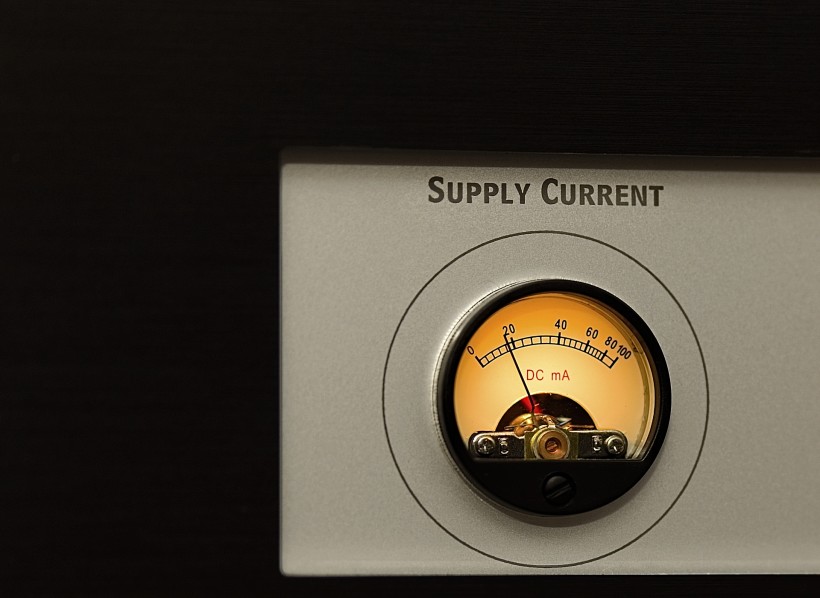 Listening to the same album while focused on Etta’s excellent vocals, proved the advantage of the tested phono precisely in terms of vocals richness, its ability to dive deeper into the texture and emotions. As a result the voice simply sounded even fuller, richer, more realistic, more present than with any of my solid-state phonostages. Although the Slovenian preamplifier seemed a bit more precise, the Vinyl Phono MC1 created a more three-dimensional presence of the singer in my room by using the mass and density and depth of the presented images. Interestingly, the former rendered a wider soundstage (even though it is also usually a tube devices attribute), and the latter was more focused on the listening axis, reaching deeper into the stage. Vocals with a more rock flair, say, Mick Jagger’s, Fish’s or John Bon Jovi’s were presented in a quite unusual yet wonderful way. On the one hand they sounded relaxed, effortless, on the other loaded with an incredible energy ready to burst at moment’s notice if needed. And it did each time as soon as the vocalists started to “scream” and LampizatOr flawlessly coped with a properly sharp, sometimes even slightly aggressive (but naturally aggressive) presentation of such rock voices.
Listening to the same album while focused on Etta’s excellent vocals, proved the advantage of the tested phono precisely in terms of vocals richness, its ability to dive deeper into the texture and emotions. As a result the voice simply sounded even fuller, richer, more realistic, more present than with any of my solid-state phonostages. Although the Slovenian preamplifier seemed a bit more precise, the Vinyl Phono MC1 created a more three-dimensional presence of the singer in my room by using the mass and density and depth of the presented images. Interestingly, the former rendered a wider soundstage (even though it is also usually a tube devices attribute), and the latter was more focused on the listening axis, reaching deeper into the stage. Vocals with a more rock flair, say, Mick Jagger’s, Fish’s or John Bon Jovi’s were presented in a quite unusual yet wonderful way. On the one hand they sounded relaxed, effortless, on the other loaded with an incredible energy ready to burst at moment’s notice if needed. And it did each time as soon as the vocalists started to “scream” and LampizatOr flawlessly coped with a properly sharp, sometimes even slightly aggressive (but naturally aggressive) presentation of such rock voices.
The aforementioned high richness/weight of the sound, the placement of its center of gravity relatively low has its advantages when playing rock music. On the one hand, the guitar riffs are energetic enough, the performances of drummers and bass guitarists sound really good, on the other hand, a bit rough/sharp treble that often happens in rock recordings was slightly softened / gilded. Not significantly, but enough to stop it being an irritating element in recordings of a slightly lesser quality and to forget about the technical side of the release and just enjoy it singing along with vocalists. Rock music is to be about fun, about pure energy, even a bit of craziness and one should expect the audio system and its elements to be able to convey all that, as the LampizatOr did. The combination of such convincing vocals, strong, full, energetic midrange, proper timing worked well even when I played AC/DC or Led Zeppelin. Almost instinctively, I reached for the remote when listening to them to pump up the volume to share such a fun performance with my neighbors (whether they wanted it or not). To be honest I rarely listen to the music loudly. That happens only when the reviewed device encourages me to do so with exceptional sound quality at high volume levels. It is not so often the case when it comes to tube devices. The Vinyl Phono MC1 belonged, however, even if unexpectedly, to this very elite group. Rocking with LampizatOr for a few days was my favorite way of spending time. I spent also a few evenings with my favorite type of recording – concerts. These well-recorded ones are able to offer an extraordinary experience, as they draw you into the world of music simply more convincingly than even the best studio productions. This is partly due to the impression of participating in the spectacle, but also to the fact that some artists need a direct contact with fans to deliver their best performances. I always try to listen to at least some live recordings with most reviewed components. When it comes to those vinyl-related (turntables, cartridges, tonearms, phonostages and so on) I usually reach for legendary recordings, such as the “Jazz at the Pawnshop” by Arne Domnerus, or “Friday night in San Francisco” by Al di Meola, Paco de Lucia and John McLaughlin, but also for Ray Brown Trio on “The red hot”, Muddy Waters and Rolling Stones from Checkerboard Lounge, or even “Live” by AC/DC. I was really counting on outstanding performance of tested phono with these albums, because the tubes are perfect for recreating the ambiance and atmosphere of a live event. The Vinyl Phono MC1 did not disappoint as it was able to convincingly render an involving concert atmosphere consisting of several elements.
I spent also a few evenings with my favorite type of recording – concerts. These well-recorded ones are able to offer an extraordinary experience, as they draw you into the world of music simply more convincingly than even the best studio productions. This is partly due to the impression of participating in the spectacle, but also to the fact that some artists need a direct contact with fans to deliver their best performances. I always try to listen to at least some live recordings with most reviewed components. When it comes to those vinyl-related (turntables, cartridges, tonearms, phonostages and so on) I usually reach for legendary recordings, such as the “Jazz at the Pawnshop” by Arne Domnerus, or “Friday night in San Francisco” by Al di Meola, Paco de Lucia and John McLaughlin, but also for Ray Brown Trio on “The red hot”, Muddy Waters and Rolling Stones from Checkerboard Lounge, or even “Live” by AC/DC. I was really counting on outstanding performance of tested phono with these albums, because the tubes are perfect for recreating the ambiance and atmosphere of a live event. The Vinyl Phono MC1 did not disappoint as it was able to convincingly render an involving concert atmosphere consisting of several elements.
One of the most important ones is the ability to take all the acoustic cues from a record and convert them into a reliably rendered, well-defined space in which the event takes place. It’s about the effect of taking the listener there instead of squeezing the musicians and audience here, into our (usually much smaller) room. The LampizatOr did really good job in this respect. It effortlessly presented small, crowded clubs, filled them with air, showed reflections of sounds from walls or other obstacles, building a reliable, three-dimensional image of a given place. Secondly, it faithfully rendered, it seems quite prosaic but it’s not, sounds coming from the audience, as well as enthusiasm, emotions of both the performers and listeners. Whether it was the clutter and cutlery clangs at the beginning of “Jazz at the Pawnshop”, the very enthusiastic fans drinking beer at the Muddy and Stones concert, or lively reactions from the bit more distant audience at the concert of three guitar virtuosos, each time the Vinyl Phono MC1 used information stored in the groove to make the fact of live performance happening in front of live audience even more credible. And since, as all good tube devices do, it also filled the whole space with lots of air, the feeling of being in a space much larger than my room was simply irresistible.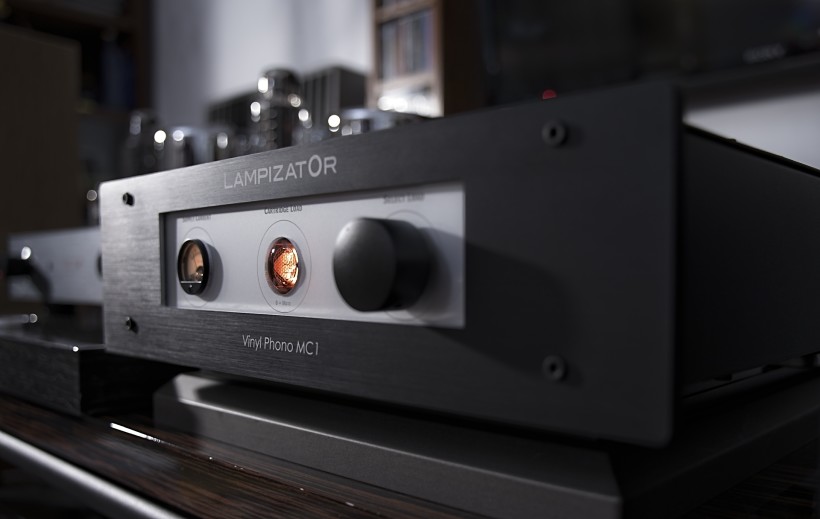 During the test, I also used two more somewhat less expensive MC cartridges – the Ortofon Cadenza Blue and Hana ML (both excellent, standing out in a positive way against the competition in the 4-7 kPLN price range). During the AVS, same as all those who attended, I could also listen to its excellent performance with one of the best cartridges on the market, the Audio Technica ART At-1000. In each case, the sound was excellent, which shows the versatility and class of the reviewed device. As always, I suggest that you listen to it in your own system and assess it yourself, but I strongly recommend that you do that if you’re on a hunt for a classy MC phonostage from this or even higher price range. It seems to me that it is worth investing in this Polish device even to accompany some cartridges from 4-6 kPLN range, because it will allow them to perform at their best, and then it will do the same when you move up to an even 2-3 times more expensive pickup. As the presentation during the Warsaw Show proved, even with the absolutely top cartridge the Vinyl Phono MC1 stood the ground and performed exceptionally well. And although the top competitors would be able to benefit even more from the top cartridges you’d have to pay way, way more for that. What I’m trying to say is that, one – this is a remarkable phonostage, two – it offers a very good value for the money too.
During the test, I also used two more somewhat less expensive MC cartridges – the Ortofon Cadenza Blue and Hana ML (both excellent, standing out in a positive way against the competition in the 4-7 kPLN price range). During the AVS, same as all those who attended, I could also listen to its excellent performance with one of the best cartridges on the market, the Audio Technica ART At-1000. In each case, the sound was excellent, which shows the versatility and class of the reviewed device. As always, I suggest that you listen to it in your own system and assess it yourself, but I strongly recommend that you do that if you’re on a hunt for a classy MC phonostage from this or even higher price range. It seems to me that it is worth investing in this Polish device even to accompany some cartridges from 4-6 kPLN range, because it will allow them to perform at their best, and then it will do the same when you move up to an even 2-3 times more expensive pickup. As the presentation during the Warsaw Show proved, even with the absolutely top cartridge the Vinyl Phono MC1 stood the ground and performed exceptionally well. And although the top competitors would be able to benefit even more from the top cartridges you’d have to pay way, way more for that. What I’m trying to say is that, one – this is a remarkable phonostage, two – it offers a very good value for the money too.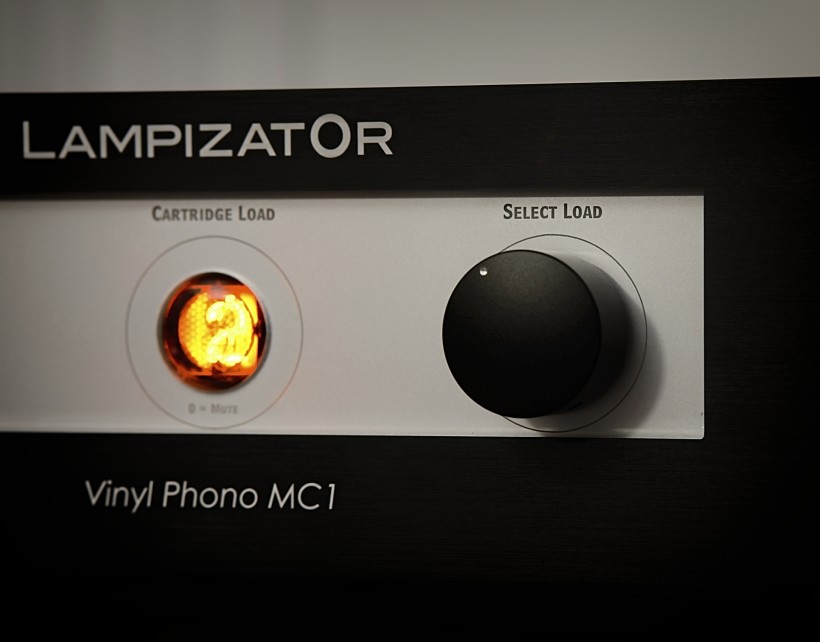
Summary
To paraphrase a well-known saying: Pacific was not built in a day. It took LampizatOr team several years before they finally built their masterpiece – the Pacific DAC, that is one of the best money can buy. The Vinyl Phono MC1, i.e. the first commercial approach to the subject of vinyl playback, is not the equivalent of the top DAC quite yet. However, since I have been following the development of the brand for years, I dare to claim, that with this phonostage LampizatOr has entered analog world with a much more bang than they did into digital world years ago. In a word, it is a damn good and promising start, which, I believe, should satisfy many vinyl record lovers, and not just those that are only at the beginning of their vinyl records adventure (not only because of the pricing that places this LampizatOr on a fairly high shelf). It’s rather a proposal for those who already know what they want, who can appreciate the naturalness and “tubeness”, in the best sense of the word, of this preamplifier’s sound, its refinement, effortlessness, dynamics as well as fantastic coherence and smoothness.
I suspect that Łukasz Fikus will not be an exception to the rule that says that those who once got hooked with vinyl stay with it forever. Therefore, I believe that the Vinyl Phono MC1 is only the first of his phonostages. It will not be easy to top, but it never is when already the first product is so damn good. Knowing the capabilities and persistence in pursue of the perfect sound of the LampizatOr team, I expect some really big things from them in the future. For now though, they’ve offered us an already excellent device, incredibly musical, smooth, coherent, dynamic, saturated, rich yet pure sounding phonostage. It allows users to not only enjoy but also experience music, which is the next level for true music lovers. Such successful debuts do not happen often in the analog world. Congratulations are therefore very much in place – great work!
Technical specification (according to manufacturer):
- Input: single, stereo RCA with adjustable loading
- Output: single, stereo, RCA, output impedance: 2kΩ
- Gain: total 3200x, (70 dB)
- Cartridge compatibility: Moving Coil (MC) cartridges only, from 0,15 mV.
- Number of input loading settings: 5
- Output level on average music material: 2V pp
- Power consumption: 40W
- AC Mains: 110/115/220/230V AC / 50 – 60Hz
- Tube compliment: 2 x 6N2P-B, 2Xecc803-s-g, 1xEL34, 1X6X5, 1 x Nixie
- Dimensions: 43×51 cm (W x D)
- Total height: 13 cm
- Weight (net / shipping): 17 kg / 25 kg
- Power supply: fully linear, 150 Watt, fully regulated
- Paid options: copper cover, NOS tubes
Price (when reviewed):
- MC only input, full tube PSU, Single ended outputs, one arm: 6600 Euro (plus VAT tax)
- MC only input, full solid state PSU, Single ended outputs, one arm: 5600 Euro (plus VAT tax)
- MM only input, full tube PSU, Single ended outputs, one arm: 4600 Euro (plus VAT tax)
- MM only input, full solid state PSU, Single ended outputs, one arm: 3900 Euro (plus VAT tax)
Manufacturer: LampizatOr
Associated equipment:
- Analogue front end: J.Sikora Standard MAX turntable, J.Sikora KV12 tonearm , AirTight PC-3, phonostages: Grandinote Celio mk IV, ESE Lab Nibiru V 5
- Digital source: a passive, custom PC with WIN10, Roon, Fidelizer Pro 7.3, JCat USB Femto card with iFi power supply, Hdplex linear power supply for PC, JCAT USB Isolator
- D/A Converter: LampizatOr Pacific +Ideon Audio 3R Master Time (USB signal regenerator)
- Power amplifiers: GrandiNote Shinai, Art Audio Symphony II (modified), LampizatOr Metamorphosis, Ayon Audio Crossfire EVO
- Preamplifier: Audia Flight FLS1
- Loudspeakers: Ubiq Audio Model ONE Duelund Edition. GrandiNote MACH4, Trenner&Friedl PHI
- Interconnects: Hijiri Million, Less Loss Anchorwave, KBL Sound Zodiac XLR, TelluriumQ Silver Diamond USB
- Speaker cables: LessLoss Anchorwave
- Power cables:LessLoss DFPC Signature, Gigawatt LC-3
- Power:Gigawatt PF-2 MK2 and Gigawatt PC-3 SE Evo+; a custom power line with Gigawatt LC-Y in-wall cable; Gigawatt G-044 Schuko and Furutech FT-SWS-D (R)
- Racks: Base VI, Rogoz Audio 3RP3/BBS
- Anti-vibration accessories: ROGOZ-AUDIO SMO40 and CPPB16 platforms and ROGOZ AUDIO BW40MKII feet, Franc Accessories Ceramic Disc Slim Feet and Wood Block Platform


